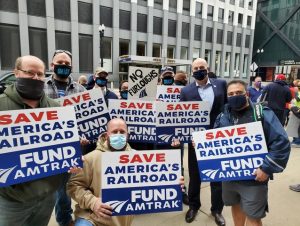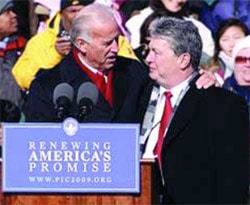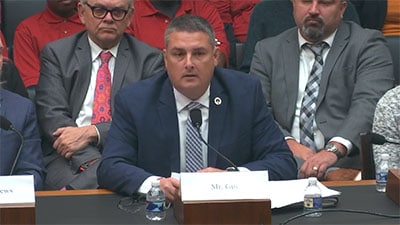In its preliminary financial report, Amtrak said that the COVID-19 pandemic has reduced ridership on the national passenger carrier by about 75% from pre-COVID levels.
While Amtrak leadership expects a slow rebound in ridership, with forecasts seeing an increase to about 40% of pre-pandemic levels by the close of the 2021 fiscal year as COVID-19 abates, the coronavirus has been a massive shock to the carrier.
“Our dedicated employees continue to work tirelessly through the pandemic to keep this country moving, advance critical infrastructure and update technology and services, and provide safe transportation to customers,” said Amtrak President & CEO William Flynn. “However, without additional funding for 2021, we will be forced to further reduce service, defer critical capital projects and make more job reductions despite this important progress.”
The Republican-controlled Senate did not act on a pair of bills — the HEROES Act and the Moving Forward Act — passed by the U.S. House of Representatives that would have provided additional emergency funding for Amtrak to maintain employment and service levels as the nation continues to cope with the coronavirus. Instead, funding was maintained at 2020 levels by Congress.
In reaction to not having the nearly $5 billion needed to maintain operations, carrier leadership reduced daily long-distance routes to three trips a week and cut about 2,000 unionized employees effective Nov. 1 over the objections of SMART-TD and other unions representing Amtrak workers.
The carrier had expected to break even for the first time in its history during the 2020 fiscal year, which ran from Oct. 2019 to Sept. 2020.
Read the carrier’s report.
Tag: Amtrak
Amtrak’s financial situation and the freight rail industry’s continued use of Precision Scheduled Railroading (PSR) practices were the focus of a U.S. Senate Commerce Committee hearing Oct. 21.
Amtrak President and CEO William Flynn repeated his plea for almost $5 billion in emergency funding to help the nation’s passenger carrier weather the continued downturn in ridership caused by the COVID-19 pandemic. The carrier has made drastic long-distance service cuts, going from daily to three trips per week on many routes. Furloughs for almost 2,000 Amtrak employees are scheduled to take effect in November.
“Virtually all of the CARES Act money has been spent,” Flynn told the committee. “These workforce adjustments are essential with current financial funding.”
A number of legislative actions, including the HEROES Act and the INVEST in America Act, while passed by the U.S. House of Representatives, have been stalled by Majority Leader Mitch McConnell in the GOP-controlled Senate. The emergency funding provided by such legislation would help the carrier rebound, Flynn said.
“Once the pandemic eases, Amtrak plans to grow,” he said.
A second panel featured a discussion of PSR.
Rudy Gordon, CEO of the National Grain and Feed Association, expressed concerns from a shipper perspective about the redeployment of furloughed railroad workers, saying that he fears delays in service and shipments on the part of rail carriers when the economy rebounds.
PSR has caused “a tipping point” at the expense of customer service, Gordon said, and said that if rail service erodes further at the expense of the carriers obtaining lower operating ratios (ORs) that the Surface Transportation Board should intervene.
Larry Willis, president of the AFL-CIO Transportation Trades Department (TTD), of which the SMART Transportation Division is a member, offered written testimony concerning PSR.
“Across the sector, the pandemic continues to wreak havoc, threatening both the health and livelihoods of employees,” Willis stated. “At the same time, freight railroads, at the insistence of Wall Street investors and hedge fund managers, have pursued operating practices that undermine basic tenets of rail safety, ask frontline workers to do more with less, and threaten the reliable and efficient customer service that should be the hallmark of this industry.”
The lone labor representative invited to testify in person was Dennis Pierce, president of the Teamsters Rail Conference.
Other industry stakeholders appearing were:
- Paul Tuss, executive director, Bear Paw Developing Corporation and Member, Montana Economic Developers Association
- Frank Chirumbole, vice president global supply chain, Olin Corporation on behalf of American Chemistry Council
- Kent Fountain, chairman, National Cotton Council
- Ian Jefferies, president and chief executive officer, Association of American Railroads
Gregg B. Weaver, a retired member of SMART-TD Local 898 who rode with former Vice President Joe Biden many times during the longtime senator’s commute from Delaware to Washington D.C., was featured in a video presented Monday, Aug. 17, during the first night of the Democratic National Convention.
In the video, the former vice president’s respect and empathy toward the SMART members who served him as he traveled on Amtrak were highlighted.
“I think he’s most comfortable around everyday, working-class people,” Weaver said. “He makes you feel like you belong.”
Another instance of Biden’s concern came after he heard that Weaver had had a heart attack, Weaver recalled in the video.
“I was in a barber shop in New York City and the phone rings,” Weaver said. “And sure enough, it’s Vice President Biden asking how I’m doing — wanted to know the whole story. Kind of funny that you’re talking to the Vice President of the United States, but if I would have told the people in the barber shop, I don’t think they would have believed me.
“I’m not saying like it was me and I’m anything special. Everyone was special to him. We have heroes all over this country … the average guy is important to him.”
CLEVELAND, Ohio (March 20, 2020) — On the heels of their joint petition to the Federal Railroad Administration (FRA) requesting an Emergency Order (EO) to address employee safety conditions in response to the national COVID-19 (coronavirus) outbreak, the SMART Transportation Division and the Brotherhood of Locomotive Engineers and Trainmen (BLET) are now asking for a similar EO for Amtrak and passenger/commuter lines.
“Therefore, it is necessary that Amtrak and all railroads providing passenger and commuter rail service to take immediate and appropriate precautions to mitigate against the spread of the virus amongst their workforces and passengers, to minimize the exposure of their employees to the virus during the performance of their duties, and to maintain sufficient staffing levels to compensate for reduced headcounts caused by sick employees and family members until the virus begins to subside,” SMART-TD President Jeremy R. Ferguson and BLET President Dennis R. Pierce wrote in their petition.
The unions’ request for an EO basically calls for an action plan to help address the potential spread of the coronavirus among rail workers by using protocols established by the Centers for Disease Control and Prevention (CDC). To date, the FRA has failed to enact such an action plan. Several components of the unions’ passenger rail EO request mirror those requested in their joint freight petition, which includes: locomotive sanitation, common room sanitation, employee temperature observation protocols, away-from-home terminal procedures, crew transportation sanitation, what to do if an employee develops symptoms, and furlough recall procedures. The unions’ petition for a passenger EO covers: coach/passenger car sanitation standards, sleeper car sanitation, and directives in case a passenger develops symptoms.
The unions suggest that 25% of furloughed rail personnel should immediately be recalled to service to deal with anticipated shortages and staffing needs, in accordance with President Trump’s invocation of the Defense Production Act.
“In order to standardize and define the best protocols across the industry for mitigation of the spread of the virus and the protection of both passengers and employees, there exists a number of safety precautions that need to be immediately ordered by FRA,” Presidents Ferguson and Pierce stated.
###
The SMART Transportation Division is comprised of approximately 125,000 active and retired members of the former United Transportation Union, who work in a variety of crafts in the transportation industry.
The Brotherhood of Locomotive Engineers and Trainmen represents nearly 58,000 professional locomotive engineers and trainmen throughout the United States. The BLET is the founding member of the Rail Conference, International Brotherhood of Teamsters.
SMART Transportation Division Illinois State Legislative Director Bob Guy testified Nov. 13 before the U.S. House Subcommittee on Railroads, Pipelines, and Hazardous Materials regarding the future of Amtrak as members of Congress continue the reauthorization process for the national passenger carrier and the Fixing America’s Surface Transportation (FAST) Act.
He touched upon the topics of assault upon workers, Amtrak funding and having a labor member on the carrier’s board.
Guy called for Congress to increase the level of appropriations reserved for Amtrak so that the carrier can go forward as an important part in the groundwork of a multimodal transportation system in the United States.
“Congress should allow Amtrak to be America’s railroad and support their ability to maintain a qualified workforce that meets customers’ demands now and well into the future,” Guy told representatives on the subcommittee.
He said steps taken by legislators in the FAST Act, including the addition of three grants administered by the Federal Railroad Administration, have helped to increase momentum for improving Amtrak’s service.
“These grants are successful, and they work.”
But operationally, there are areas of concern — Guy urged representatives to preserve and protect Amtrak’s long-distance service, which had been in jeopardy of being axed last year — especially the Southwest Chief route — before legislators stepped in.
On the administrative side, Guy said the Amtrak Board of Directors should have a member from labor on it, mirroring what the Railroad Retirement Board does, Guy said. Often, the experiences of SMART TD members and other unionized workers who keep Amtrak running day to day can be enlightening on what to do and what not to do when running the railroad, he said.
“Passengers interact with our members on board trains,” Guy said. “We hear concerns and complaints … having a labor member at a board level will help Amtrak make decisions that could affect service.”
Guy said employees also are not given enough resources to deal with violence against them. Carrier-provided protections for Amtrak’s rail workers such as de-escalation and self-defense training aren’t there, he said, and neither is counseling after an incidence of violence occurs. SMART TD brother Michael Case was shot in 2017, and the incident spurred the introduction of legislation to treat the punishment of transit worker assaults the same as those perpetrated on airline workers.
Guy was one of three labor representatives who discussed the carrier’s relationship with labor. Over the past year, Amtrak has engaged in what has been described by some as “union busting” behavior, especially as it concerns cuts to the jobs of unionized call-center and food-service workers, police officers and rural station agents.
“When you are reducing the workforce that’s in charge of inspections and fixing equipment and whatnot, it makes it hard to keep things in a state of good repair, regardless if new equipment is coming,” Guy said. “I wouldn’t want to see worker reductions to the point where safety is jeopardized. We don’t think it is, but that’s a path we wouldn’t want to see.”
Amtrak reported a positive fiscal 2019 with an increase in ridership, a decrease in operating loss and an increase in operating revenue, but subcommittee Chairman Dan Lipinski, who represents Illinois’ 3rd District, was highly critical of the carrier’s cuts that helped to achieve those results in his opening remarks.
“Amtrak clearly has decided that the way to prosperity is to have its workers pay for it,” Lipinski said. “This is not the way to run this railroad.”
Among the cuts were about 500 jobs at a call center in Riverside, Calif. About 350 of those jobs were later brought back at non-union sites.
“Amtrak used to be an enviable place to work,” said Jack Dinsdale, national vice president of the Transportation Communications Union, in criticizing the loss of those union jobs. “It was about union busting, period.”
Also testifying on labor’s behalf was Dan Regan, secretary of the AFL-CIO’s Transportation Trades Department.
Watch the entire hearing.
A U.S. senator from Kansas received an assurance in a letter from Amtrak’s president and CEO that the national passenger carrier will maintain long-distance service at its current status quo through the 2019 fiscal year, which ends Sept. 30, and possibly on through the enactment period of the Fixing America’s Surface Transportation (FAST) Act, which runs through the 2020 fiscal year.
However, U.S. Sen. Jerry Moran’s delay on the consideration by the U.S. Senate of three presidential nominees to the Amtrak Board of Directors, which he started in early May, appears that it will continue.
Kansas News Service (ksnewsservice.org) reported that a spokesperson for the senator said a May 22 in-person meeting between Moran and Anderson was a “step in the right direction.” However, the holds Moran placed on President Donald Trump’s nominations to the Amtrak Board of Directors will remain while he awaits more answers to questions that arose from that meeting, the report said.
Moran is particularly concerned about the long-term future of the daily Chicago-to-Los Angeles Southwest Chief route. Last year, U.S. senators had to pressure the carrier to continue the route, which serves many rural areas, through the 2019 fiscal year.
Amtrak’s top boss, Richard Anderson, wrote in a letter to Moran that congressional action has secured the short-term future of the long-distance routes.
“We believe that Congress generally endorsed continued operation of our current route network for the five-year period from FY15-FY20 through the enactment of the Fixing America’s Surface Transportation (FAST) Act,” Anderson wrote. “Thus, although Amtrak is not technically required to operate any given route under the FAST Act, we plan on operating all of our long-distance trains for the remainder of this period while seeking to drive improved performance consistent with our goal to grow ridership while reducing Federal subsidies.”
However, Anderson also indicated that alterations to the long-distance interstate service again will be considered as the carrier seeks to build upon its recent performance, with increased ridership and record-setting fiscal performance with higher revenue and reduced operating losses.
“… We must position ourselves to attract a new generation of customers. Just as other modes of transportation and businesses are compelled to evolve, so must we if our mode is to grow as a relevant and efficient means of mass transportation,” Anderson wrote. “We owe this to our customers and your constituents, along with our nearly 20,000 hard-working and dedicated employees. That is why we have a plan to break even on operating results by 2020.”
Anderson went into detail about the financial performance and cost of the carrier’s long-distance routes and said more than half of the federal appropriations that Amtrak received went toward funding those routes.
“Long-distance trains require large federal subsidies because their revenues are lower and operating costs are higher than Amtrak’s state-supported and NEC (Northeast Corridor) services. The federal government is virtually the only funding source for the capital investments they require,” Anderson wrote. “These costs are set to increase significantly in the future as we face host railroad-related poor on-time performance across the network and much of our equipment used in long distance service reaches the end of its useful life and requires replacement.”
Discussion of an upcoming funding reauthorization in Congress will give a clearer indication of the future of the long-distance routes, Anderson said.
“Looking forward, we aim to have a conversation with Congress and our other stakeholders about the future of the long-distance services,” Anderson wrote. “While we strongly believe that there is a permanent place for high quality long-distance trains in our network, the time to closely examine the size and nature of that role is upon us for numerous reasons.”
The replacement of long-distance routes with new corridor service is certainly on the table for Amtrak, Anderson said. Among potential corridors warranting further study are Mobile, Alabama to New Orleans; Fort Worth, Texas to Newton, Kansas; Minneapolis and St. Paul, Minnesota to Chicago and Duluth, and the Front Range Corridor.
An initial analysis of these potential corridor routes is expected to be performed this summer, he wrote.
“Demand for shorter rail trips in corridors between major cities is increasing, particularly in the fast-growing South, Southwest and Mountain states,” Anderson wrote. “However, the minimal service Amtrak currently provides in these regions, with long-distance trains that are often many hours late and serve major cities in the middle of the night, does not meet the needs of their rapidly increasing populations.”
Follow this link to read Anderson’s full letter to the senator.
The three nominees whose nominations have been placed on hold by Moran are Rick Dearborn, Joseph Gruters and former U.S. Rep. Lynn Westmoreland. SMART TD opposes Westmoreland’s nomination.
At a meeting last week involving Metra and suburban Chicago city leaders, U.S. Rep. Dan Lipinski, chairman of the U.S. House Subcommittee on Railroads, Pipelines and Hazardous Materials, told the carrier that it needed to step up its performance.
“Too often, Metra riders are not getting the service that they deserve,” Lipinski said in a news release. “I said in a town hall I held in December to address problems on the BNSF line that 2019 needs to be a better year for all Metra riders. Metra is still coming up frustratingly short. It is time to stop passing the buck and find solutions.”
Metra struggled with a technology outage involving Amtrak at Union Station in February, which prompted the April 16 meeting, according to the Joliet Herald News.
Read the full story in the Herald News.
Read Lipinski’s news release.
U.S. Senator Jon Tester (D – Mont.) recently criticized the Trump administration for budget proposals that would cut funding for Amtrak rural services, especially the Montana Empire Builder line, and wrote Amtrak’s President Richard Anderson asking for accountability and answers.
“Congress purposely created a national network of long-distance and state-supported train service throughout the nation, in recognition of the importance of a transportation system that reaches every community — regardless of how rural it may be. Amtrak is more than a collection of individual train routes: it is a web of essential connections that bind our country together and link rural communities with major markets and economic opportunities. It provides residents of these communities with transportation options on which families, seniors, and businesses rely to access jobs, create economic opportunities, see our beautiful country. and visit family,” Tester’s letter to Anderson stated. “The federal investment in Amtrak ensures the small, mid-size, and rural communities served by Amtrak’s long-distance and state-supported routes continue to receive this essential service.”
Tester also posed the question to Amtrak as to why ticket agents have been eliminated and questioned the accounting methods the carrier is using to determine the cost of long-distance services. He also questioned leadership’s claims that long-distance service is down despite 2017 figures that showed that ridership is up 10.6% from the previous eight years. He asked that Amtrak address his questions by no later than April 29.
Sen. Tester’s bipartisan letter includes signatures from 10 other senators, including Tom Udall, Michael Bennet, Pat Roberts, Cory Gardner, Jerry Moran, Catherine Cortez Masto, Martin Heinrich, Joe Manchin III, Dick Durbin and Kyrsten Sinema.
In other news, Amtrak’s Hoosier State line also is on the chopping block due to Indiana backing out on funding for the 196-mile Amtrak route. The carrier has stopped ticket sales for the Chicago-to-Indianapolis Hoosier State line after July 1.
Click here to read Sen. Tester’s letter to Amtrak.




